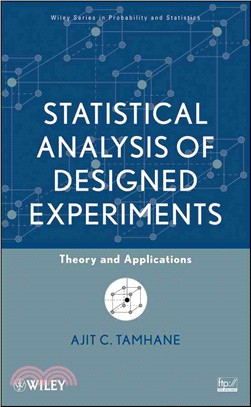Statistical Analysis Of Designed Experiments: Theory And Applications
商品資訊
系列名:Wiley Series in Probability and Statistics
ISBN13:9780471750437
出版社:John Wiley & Sons Inc
作者:Tamhane
出版日:2009/03/18
裝訂/頁數:精裝/720頁
定價
:NT$ 7712 元優惠價
:90 折 6941 元
若需訂購本書,請電洽客服 02-25006600[分機130、131]。
商品簡介
作者簡介
目次
相關商品
商品簡介
A indispensable guide to understanding and designing modern experiments
The tools and techniques of Design of Experiments (DOE) allow researchers to successfully collect, analyze, and interpret data across a wide array of disciplines. Statistical Analysis of Designed Experiments provides a modern and balanced treatment of DOE methodology with thorough coverage of the underlying theory and standard designs of experiments, guiding the reader through applications to research in various fields such as engineering, medicine, business, and the social sciences.
The book supplies a foundation for the subject, beginning with basic concepts of DOE and a review of elementary normal theory statistical methods. Subsequent chapters present a uniform, model-based approach to DOE. Each design is presented in a comprehensive format and is accompanied by a motivating example, discussion of the applicability of the design, and a model for its analysis using statistical methods such as graphical plots, analysis of variance (ANOVA), confidence intervals, and hypothesis tests.
Numerous theoretical and applied exercises are provided in each chapter, and answers to selected exercises are included at the end of the book. An appendix features three case studies that illustrate the challenges often encountered in real-world experiments, such as randomization, unbalanced data, and outliers. MinitabR software is used to perform analyses throughout the book, and an accompanying FTP site houses additional exercises and data sets.
With its breadth of real-world examples and accessible treatment of both theory and applications, Statistical Analysis of Designed Experiments is a valuable book for experimental design courses at the upper-undergraduate and graduate levels. It is also an indispensable reference for practicing statisticians, engineers, and scientists who would like to further their knowledge of DOE.
The tools and techniques of Design of Experiments (DOE) allow researchers to successfully collect, analyze, and interpret data across a wide array of disciplines. Statistical Analysis of Designed Experiments provides a modern and balanced treatment of DOE methodology with thorough coverage of the underlying theory and standard designs of experiments, guiding the reader through applications to research in various fields such as engineering, medicine, business, and the social sciences.
The book supplies a foundation for the subject, beginning with basic concepts of DOE and a review of elementary normal theory statistical methods. Subsequent chapters present a uniform, model-based approach to DOE. Each design is presented in a comprehensive format and is accompanied by a motivating example, discussion of the applicability of the design, and a model for its analysis using statistical methods such as graphical plots, analysis of variance (ANOVA), confidence intervals, and hypothesis tests.
Numerous theoretical and applied exercises are provided in each chapter, and answers to selected exercises are included at the end of the book. An appendix features three case studies that illustrate the challenges often encountered in real-world experiments, such as randomization, unbalanced data, and outliers. MinitabR software is used to perform analyses throughout the book, and an accompanying FTP site houses additional exercises and data sets.
With its breadth of real-world examples and accessible treatment of both theory and applications, Statistical Analysis of Designed Experiments is a valuable book for experimental design courses at the upper-undergraduate and graduate levels. It is also an indispensable reference for practicing statisticians, engineers, and scientists who would like to further their knowledge of DOE.
作者簡介
Ajit C. Tamhane, PhD, is Professor of Industrial Engineering and Management Sciences and Senior Associate Dean of the McCormick School of Engineering and Applied Science at Northwestern University. A Fellow of the American Statistical Society, Dr. Tamhane has over thirty years of academic and consulting experience in the areas of applied and mathematical statistics. He is the coauthor of Multiple Comparison Procedures, also published by Wiley.
目次
1. Introduction.
1.1 Observational Studies and Experiments.
1.2 Brief Historical Remarks.
1.3 Basic Terminology and Concepts of Experimentation.
1.4 Basic Principles of Experimentation.
2. Review of Elementary Statistics.
2.1 Experiments for a Single Treatment.
2.2 Experiments for Comparing Two Treatments.
2.3 Linear Regression.
2.4 Chapter Summary.
Exercises.
3. Single Factor Experiments: Completely Randomized Designs.
3.1 Summary Statistics and Graphical Displays.
3.2 Model.
3.3 Statistical Analysis.
3.4 Model Diagnostics.
3.5 Data Transformations.
3.6 Power of the F-test and Sample Size Determination.
3.7 Quantitative Treatment Factors.
3.8 One-Way Analysis of Covariance.
3.9 Chapter Notes.
3.10 Chapter Summary.
Exercises.
4. Single Factor Experiments: Multiple Comparison and Selection Procedures.
4.1 Basic Concepts of Multiple Comparisons.
4.2 Pairwise Comparisons.
4.3 Comparisons with a Control.
4.4 General Contrasts.
4.5 Ranking and Selection Procedures.
4.6 Chapter Summary.
Exercises.
5. Randomized Block Designs and Extensions.
5.1 Randomized Block (RB) Designs.
5.2 Balanced Incomplete Block (BIB) Designs.
5.3 Youden Square (YSQ) Designs.
5.4 Latin Square (LSQ) Designs.
5.5 Chapter Notes.
5.6 Chapter Summary.
Exercises.
6. General Factorial Experiments.
6.1 Factorial vs. One-Factor-at-a-Time Experiments.
6.2 Balanced Two-Way Layouts.
6.3 Unbalanced Two-Way Layouts.
6.4 Chapter Notes.
6.5 Chapter Summary.
Exercises.
7. Two-Level Factorial Experiments.
7.1 Estimation of Main Effects and Interactions.
7.2 Statistical Analysis.
7.3 Single Replicate Case.
7.4 Factorial Designs in Incomplete Blocks: Confounding of Effects.
7.5 Chapter Notes.
7.6 Chapter Summary.
Exercises.
8. Two-Level Fractional Factorial Experiments .
8.1 Two-Level Fractional Factorial Experiments.
8.2 Plackett-Burman Designs.
8.3 Hadamard Designs.
8.4 Supersaturated Designs.
8.5 Orthogonal Arrays.
8.6 Sequential Assemblies of Fractional Factorials.
8.7 Chapter Summary.
Exercises.
9. Three-Level and Mixed-Level Factorial Designs.
9.1 Three-Level Full Factorial Designs.
9.2 Three-Level Fractional Factorial Designs.
9.3 Mixed-Level Factorial Designs.
9.4 Chapter Notes.
9.5 Chapter Summary.
Exercises.
10. Experiments for Response Optimization.
10.1 Response Surface Methodology.
10.2 Mixture.
10.3 The Taguchi Method of Quality Improvement.
10.4 Chapter Summary.
Exercises.
11. Random and Mixed Crossed Factors Designs.
11.1 One-Way Layouts.
11.2 Two-Way Layouts.
11.3 Three-Way Layouts.
11.4 Chapter Notes.
11.5 Chapter Summary.
Exercises.
12. Nested, Crossed-Nested and Split Plot Designs.
12.1 Two-Stage Nested Designs.
12.2 Three-Stage Nested Designs.
12.3 Crossed and Nested Designs.
12.4 Split Plot Designs.
12.5 Chapter Notes.
12.6 Chapter Summary.
Exercises.
13. Repeated Measures Designs.
13.1 Repeated Measures Designs: Univariate Approach.
13.2 Repeated Measures Designs: Multivariate Approach.
13.3 Chapter Notes.
13.4 Chapter Summary.
Exercises.
14. Linear Models with Fixed Effects.
14.1 Basic Linear Model and Least Squares Estimation.
14.2 Confidence Intervals and Hypothesis Testing.
14.3 Power of the F-Test.
14.4 Chapter Notes.
14.5 Chapter Summary.
Exercises.
A. Vector-Valued Random Variables and Some Distribution Theory.
A.1 Mean Vector and Covariance Matrix of a Random Vector.
A.2 Covariance Matrix of a Linear Transformation of a Random Vector.
A.3 Multivariate Normal Distribution.
A.4 Chi-Square, F and t-Distributions.
A.5 Distributions of Quadratic Forms.
A.6 Multivariate t-Distribution.
A.7 Multivariate Normal Sampling Distribution Theory.
B. Case Studies.
B.1 Case Study 1: Effects of Field Strength and Flip Angle on MRI Contrast.
B.1.1 Background.
B.1.2 Design.
B.1.3 Data Analysis.
B.1.4 Results.
B.2 Case Study 2: Growing Stem Cells for Bone Implants.
B.2.1 Background.
B.2.2 Design.
B.2.3 Data Analysis.
B.2.4 Results.
B.3 Case Study 3: Router Bit Experiment.
B.3.1 Background.
B.3.2 Design.
B.3.3 Data Analysis.
B.3.4 Results.
1.1 Observational Studies and Experiments.
1.2 Brief Historical Remarks.
1.3 Basic Terminology and Concepts of Experimentation.
1.4 Basic Principles of Experimentation.
2. Review of Elementary Statistics.
2.1 Experiments for a Single Treatment.
2.2 Experiments for Comparing Two Treatments.
2.3 Linear Regression.
2.4 Chapter Summary.
Exercises.
3. Single Factor Experiments: Completely Randomized Designs.
3.1 Summary Statistics and Graphical Displays.
3.2 Model.
3.3 Statistical Analysis.
3.4 Model Diagnostics.
3.5 Data Transformations.
3.6 Power of the F-test and Sample Size Determination.
3.7 Quantitative Treatment Factors.
3.8 One-Way Analysis of Covariance.
3.9 Chapter Notes.
3.10 Chapter Summary.
Exercises.
4. Single Factor Experiments: Multiple Comparison and Selection Procedures.
4.1 Basic Concepts of Multiple Comparisons.
4.2 Pairwise Comparisons.
4.3 Comparisons with a Control.
4.4 General Contrasts.
4.5 Ranking and Selection Procedures.
4.6 Chapter Summary.
Exercises.
5. Randomized Block Designs and Extensions.
5.1 Randomized Block (RB) Designs.
5.2 Balanced Incomplete Block (BIB) Designs.
5.3 Youden Square (YSQ) Designs.
5.4 Latin Square (LSQ) Designs.
5.5 Chapter Notes.
5.6 Chapter Summary.
Exercises.
6. General Factorial Experiments.
6.1 Factorial vs. One-Factor-at-a-Time Experiments.
6.2 Balanced Two-Way Layouts.
6.3 Unbalanced Two-Way Layouts.
6.4 Chapter Notes.
6.5 Chapter Summary.
Exercises.
7. Two-Level Factorial Experiments.
7.1 Estimation of Main Effects and Interactions.
7.2 Statistical Analysis.
7.3 Single Replicate Case.
7.4 Factorial Designs in Incomplete Blocks: Confounding of Effects.
7.5 Chapter Notes.
7.6 Chapter Summary.
Exercises.
8. Two-Level Fractional Factorial Experiments .
8.1 Two-Level Fractional Factorial Experiments.
8.2 Plackett-Burman Designs.
8.3 Hadamard Designs.
8.4 Supersaturated Designs.
8.5 Orthogonal Arrays.
8.6 Sequential Assemblies of Fractional Factorials.
8.7 Chapter Summary.
Exercises.
9. Three-Level and Mixed-Level Factorial Designs.
9.1 Three-Level Full Factorial Designs.
9.2 Three-Level Fractional Factorial Designs.
9.3 Mixed-Level Factorial Designs.
9.4 Chapter Notes.
9.5 Chapter Summary.
Exercises.
10. Experiments for Response Optimization.
10.1 Response Surface Methodology.
10.2 Mixture.
10.3 The Taguchi Method of Quality Improvement.
10.4 Chapter Summary.
Exercises.
11. Random and Mixed Crossed Factors Designs.
11.1 One-Way Layouts.
11.2 Two-Way Layouts.
11.3 Three-Way Layouts.
11.4 Chapter Notes.
11.5 Chapter Summary.
Exercises.
12. Nested, Crossed-Nested and Split Plot Designs.
12.1 Two-Stage Nested Designs.
12.2 Three-Stage Nested Designs.
12.3 Crossed and Nested Designs.
12.4 Split Plot Designs.
12.5 Chapter Notes.
12.6 Chapter Summary.
Exercises.
13. Repeated Measures Designs.
13.1 Repeated Measures Designs: Univariate Approach.
13.2 Repeated Measures Designs: Multivariate Approach.
13.3 Chapter Notes.
13.4 Chapter Summary.
Exercises.
14. Linear Models with Fixed Effects.
14.1 Basic Linear Model and Least Squares Estimation.
14.2 Confidence Intervals and Hypothesis Testing.
14.3 Power of the F-Test.
14.4 Chapter Notes.
14.5 Chapter Summary.
Exercises.
A. Vector-Valued Random Variables and Some Distribution Theory.
A.1 Mean Vector and Covariance Matrix of a Random Vector.
A.2 Covariance Matrix of a Linear Transformation of a Random Vector.
A.3 Multivariate Normal Distribution.
A.4 Chi-Square, F and t-Distributions.
A.5 Distributions of Quadratic Forms.
A.6 Multivariate t-Distribution.
A.7 Multivariate Normal Sampling Distribution Theory.
B. Case Studies.
B.1 Case Study 1: Effects of Field Strength and Flip Angle on MRI Contrast.
B.1.1 Background.
B.1.2 Design.
B.1.3 Data Analysis.
B.1.4 Results.
B.2 Case Study 2: Growing Stem Cells for Bone Implants.
B.2.1 Background.
B.2.2 Design.
B.2.3 Data Analysis.
B.2.4 Results.
B.3 Case Study 3: Router Bit Experiment.
B.3.1 Background.
B.3.2 Design.
B.3.3 Data Analysis.
B.3.4 Results.
主題書展
更多
主題書展
更多書展今日66折
您曾經瀏覽過的商品
購物須知
外文書商品之書封,為出版社提供之樣本。實際出貨商品,以出版社所提供之現有版本為主。部份書籍,因出版社供應狀況特殊,匯率將依實際狀況做調整。
無庫存之商品,在您完成訂單程序之後,將以空運的方式為你下單調貨。為了縮短等待的時間,建議您將外文書與其他商品分開下單,以獲得最快的取貨速度,平均調貨時間為1~2個月。
為了保護您的權益,「三民網路書店」提供會員七日商品鑑賞期(收到商品為起始日)。
若要辦理退貨,請在商品鑑賞期內寄回,且商品必須是全新狀態與完整包裝(商品、附件、發票、隨貨贈品等)否則恕不接受退貨。
























